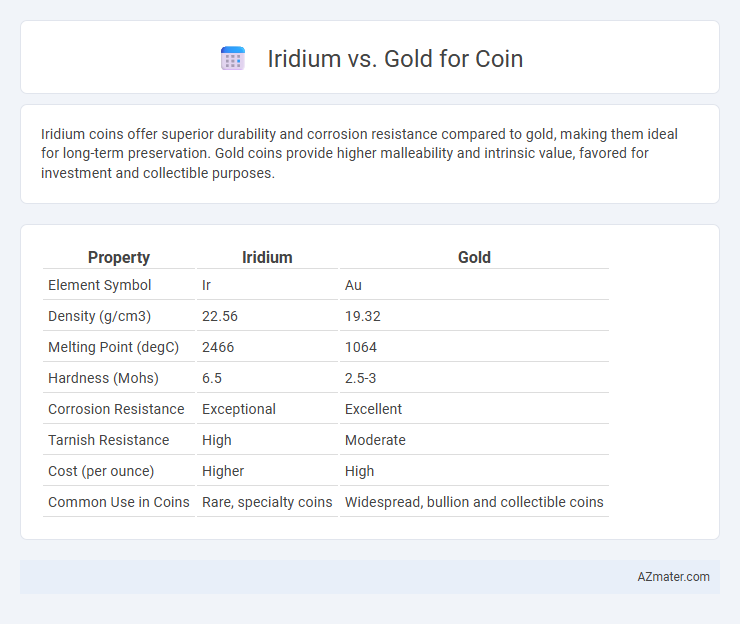Iridium coins offer superior durability and corrosion resistance compared to gold, making them ideal for long-term preservation. Gold coins provide higher malleability and intrinsic value, favored for investment and collectible purposes.
Table of Comparison
| Property | Iridium | Gold |
|---|---|---|
| Element Symbol | Ir | Au |
| Density (g/cm3) | 22.56 | 19.32 |
| Melting Point (degC) | 2466 | 1064 |
| Hardness (Mohs) | 6.5 | 2.5-3 |
| Corrosion Resistance | Exceptional | Excellent |
| Tarnish Resistance | High | Moderate |
| Cost (per ounce) | Higher | High |
| Common Use in Coins | Rare, specialty coins | Widespread, bullion and collectible coins |
Introduction: Iridium vs Gold Coins
Iridium coins exhibit unmatched durability and resistance to corrosion, making them ideal for long-term preservation compared to traditional gold coins. Gold coins are prized for their intrinsic value and historical significance, but iridium's rarity and resilience offer a modern alternative with increased longevity. Both metals present distinct advantages for collectors and investors seeking reliable and valuable coinage options.
Historical Use of Iridium and Gold in Coins
Gold has been historically favored for coinage due to its rarity, malleability, and resistance to corrosion, with civilizations from ancient Lydia to modern times minting gold coins as symbols of wealth and stability. Iridium, a rare and extremely hard platinum-group metal, has seen limited historical use in coins, primarily in specialized or commemorative issues where its durability and distinctive properties are valued. The significant contrast in their historical use underscores gold's dominant role in conventional coinage versus iridium's niche application in modern, high-durability or collector coins.
Physical Properties Comparison
Iridium exhibits exceptional hardness and corrosion resistance, making it one of the most durable metals for coin production, with a melting point of 2446degC and a density of 22.56 g/cm3. Gold, with a melting point of 1064degC and a density of 19.32 g/cm3, is softer and more malleable, which facilitates detailed embossing but reduces wear resistance over time. Both metals possess high density and luster, yet iridium's superior scratch resistance and chemical inertness offer enhanced longevity compared to gold in coin applications.
Rarity and Availability
Iridium is one of the rarest elements in the Earth's crust, far less abundant than gold, making iridium coins exceptionally scarce and valuable for collectors. Gold is more widely available and historically used in coinage due to its malleability and resistance to tarnish, but iridium's rarity and high melting point contribute to its uniqueness in limited-edition coins. The scarcity of iridium combined with its industrial demand drives up its market value, distinguishing it sharply from the more commonly circulated gold coins.
Durability and Longevity
Iridium coins exhibit exceptional durability due to iridium's hardness and resistance to corrosion, making them ideal for long-lasting collectibles. Gold coins, while highly valued for their malleability and resistance to tarnish, are softer and more prone to scratches and wear over time. The superior endurance of iridium ensures coins maintain their structural integrity and appearance far longer than gold counterparts in harsh environments.
Investment Value Analysis
Iridium coins exhibit high investment value due to their rarity, exceptional durability, and resistance to corrosion, making them a unique collector's asset compared to traditional gold coins. Gold remains a globally recognized store of value with a stable market, strong liquidity, and extensive historical demand, ensuring consistent investment returns. Investors seeking diversification may consider iridium for its scarcity and industrial applications, while gold provides established market security and broad acceptance.
Industrial and Technological Applications
Iridium's exceptional corrosion resistance and high melting point make it invaluable in industrial applications such as spark plugs, crucibles, and electrical contacts, outperforming gold in durability under extreme conditions. Gold, renowned for its superior electrical conductivity and malleability, is widely used in electronic connectors, semiconductors, and precision circuitry, ensuring reliable performance in technology devices. Both metals serve critical roles in high-tech industries, with iridium excelling in harsh environments and gold dominating in conductive applications.
Aesthetic Appeal and Collectibility
Iridium coins boast a unique silvery-white luster with exceptional durability, making them visually striking and highly resistant to tarnishing compared to traditional gold coins. Gold coins maintain a timeless warm yellow hue prized for centuries and often signal wealth and prestige, enhancing their aesthetic appeal. Collectors highly value gold for its historical significance and liquidity, while iridium's rarity and modern allure attract niche markets seeking novel and enduring collectible metals.
Security and Anti-Counterfeiting Features
Iridium coins offer exceptional security due to their high density and corrosion resistance, making them extremely difficult to replicate or alter compared to gold coins. Gold coins, while traditionally valued, are more susceptible to counterfeiting methods such as plating and alloy substitution, despite sophisticated minting technologies. Advanced anti-counterfeiting features in iridium coins include unique micro-engraving and electromagnetic signature verification, enhancing authenticity and long-term security for collectors and investors.
Conclusion: Choosing Between Iridium and Gold Coins
Iridium coins offer exceptional durability and resistance to corrosion, making them ideal for long-term preservation and intricate designs, while gold coins provide timeless value, wide acceptance, and liquidity in global markets. Investors seeking rarity and durability may lean towards iridium, whereas those prioritizing established market recognition and historical significance typically prefer gold. The choice ultimately depends on individual priorities regarding metal properties, investment goals, and collectible value.

Infographic: Iridium vs Gold for Coin
 azmater.com
azmater.com